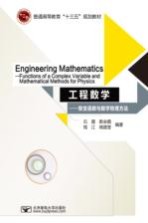图书介绍
普通高等教育“十三五”规划教材 工程数学 复变函数与数学物理方法 英文版PDF|Epub|txt|kindle电子书版本网盘下载

- 石霞,默会霞,钱江,杨建奎著 著
- 出版社: 北京:北京邮电大学出版社
- ISBN:9787563552641
- 出版时间:2017
- 标注页数:245页
- 文件大小:32MB
- 文件页数:268页
- 主题词:工程数学-高等学校-教材
PDF下载
下载说明
普通高等教育“十三五”规划教材 工程数学 复变函数与数学物理方法 英文版PDF格式电子书版下载
下载的文件为RAR压缩包。需要使用解压软件进行解压得到PDF格式图书。建议使用BT下载工具Free Download Manager进行下载,简称FDM(免费,没有广告,支持多平台)。本站资源全部打包为BT种子。所以需要使用专业的BT下载软件进行下载。如BitComet qBittorrent uTorrent等BT下载工具。迅雷目前由于本站不是热门资源。不推荐使用!后期资源热门了。安装了迅雷也可以迅雷进行下载!
(文件页数 要大于 标注页数,上中下等多册电子书除外)
注意:本站所有压缩包均有解压码: 点击下载压缩包解压工具
图书目录
Part Ⅰ Functions of a Complex Variable3
Chapter 1 Complex Numbers and Complex Functions3
1.1 Complex number and its operations3
1.1.1 Complex number and its expression3
1.1.2 The operations of complex numbers6
1.1.3 Regions in the complex plane13
Exercises 1.114
1.2 Functions of a complex variable15
1.2.1 Definition of function of a complex variable15
1.2.2 Complex mappings17
Exercises 1.220
1.3 Limit and continuity of a complex function21
1.3.1 Limit of a complex function21
1.3.2 Continuity of a complex function26
Exercises 1.327
Chapter 2 Analytic Functions29
2.1 Derivatives of complex functions29
2.1.1 Derivatives29
2.1.2 Some properties of derivatives31
2.1.3 A necessary condition on differentiability31
2.1.4 Sufficient conditions on differentiability34
Exercises 2.136
2.2 Analytic functions37
2.2.1 Analytic functions37
2.2.2 Harmonic functions39
Exercises 2.241
2.3 Elementary functions41
2.3.1 Exponential functions41
2.3.2 Logarithmic functions42
2.3.3 Complex exponents45
2.3.4 Trigonometric functions46
2.3.5 Hyperbolic functions48
2.3.6 Inverse trigonometric and hyperbolic functions49
Exercises 2.350
Chapter 3 Integral of Complex Function52
3.1 Derivatives and definite integrals of functionsw(t)52
3.1.1 Derivatives of functionsw(t)52
3.1.2 Definite integrals of functionsw(t)53
Exercises 3.156
3.2 Contour integral56
3.2.1 Contour56
3.2.2 Definition of contour integral58
3.2.3 Antiderivatives66
Exercises 3.273
3.3 Cauchy integral theorem75
3.3.1 Cauchy-Goursat theorem75
3.3.2 Simply and multiply connected domains76
Exercises 3.380
3.4 Cauchy integral formula and derivatives of analytic functions81
3.4.1 Cauchy integral formula81
3.4.2 Higher-order derivatives formula of analytic functions84
Exercises 3.487
Chapter 4 Complex Series89
4.1 Complex series and its convergence89
4.1.1 Complex sequences and its convergence89
4.1.2 Complex series and its convergence90
Exercises 4.193
4.2 Power series93
4.2.1 The definition of power series93
4.2.2 The convergence of power series95
4.2.3 The operations of power series97
Exercises 4.297
4.3 Taylor series98
4.3.1 Taylor's theorem98
4.3.2 Taylor expansions of analytic functions100
Exercises 4.3104
4.4 Laurent series105
4.4.1 Laurent's theorem105
4.4.2 Laurent series expansion of analytic functions109
Exercises 4.4111
Chapter 5 Residues and Its Application113
5.1 Three types of isolated singular points113
Exercises 5.1118
5.2 Residues and Cauchy's residue theorem118
Exercises 5.2123
5.3 Application of residues on definite integrals123
5.3.1 Improper integrals124
5.3.2 Improper integrals involving sines and cosines125
5.3.3 Integrals on[0,2π]involving sines and cosines128
Exercises 5.3130
Part Ⅱ Mathematical Methods for Physics135
Chapter 6 Equations of Mathematical Physics and Problems for Defining Solutions135
6.1 Basic concept and definition135
6.1.1 Basic concept136
6.1.2 Linear operator and linear composition138
6.1.3 Calculation rule of operator140
6.2 Three typical partial differential equations and problems for defining solutions141
6.2.1 Wave equations and physical derivations141
6.2.2 Heat(conduction)equations and physical derivations143
6.2.3 Laplace equations and physical derivations144
6.3 Well-posed problem145
6.3.1 Initial conditions146
6.3.2 Boundary conditions146
Chapter 7 Classification and Simplification for Linear Second Order PDEs148
7.1 Classification of linear second order partial differential equations with two variables148
Exercises 7.1149
7.2 Simplification to standard forms149
Exercises 7.2156
Chapter 8 Integral Method on Characteristics158
8.1 D'Alembert formula for one dimensional infinite string oscillation158
Exercises 8.1160
8.2 Small oscillations of semi-infinite string with rigidly fixed or free ends,method of prolongation160
Exercises 8.2162
8.3 Integral method on characteristics for other second order PDEs,some examples162
Exercises 8.3165
Chapter 9 The Method of Separation of Variables on Finite Region166
9.1 Separation of variables for(1+1)-dimensional homogeneous equations167
9.1.1 Separation of variables for wave equation on finite region167
9.1.2 Separation of variables for heat equation on finite region170
Exercises 9.1172
9.2 Separation of variables for 2-dimensional Laplace equations174
9.2.1 Laplace equation with rectangular boundary174
9.2.2 Laplace equation with circular boundary177
Exercises 9.2180
9.3 Nonhomogeneous equations and nonhomogeneous boundary conditions181
Exercises 9.3192
9.4 Sturm-Liouville eigenvalue problem192
Exercises 9.4198
Chapter 10 Special Functions199
10.1 Bessel function199
10.1.1 Introduction to the Bessel equation199
10.1.2 The solution of the Bessel equation201
10.1.3 The recurrence formula of the Bessel function204
10.1.4 The properties of the Bessel function207
10.1.5 Application of Bessel function210
Exercises 10.1213
10.2 Legendre polynomial214
10.2.1 Introduction of the Legendre equation214
10.2.2 The solution of the Legendre equation216
10.2.3 The properties of the Legendre polynomial and recurrence formula218
10.2.4 Application of Legendre polynomial221
Exercises 10.2223
Chapter 11 Integral Transformations224
11.1 Fourier integral transformation224
11.1.1 Definition of Fourier integral transformation225
11.1.2 The properties of Fourier integral transformation228
11.1.3 Convolution and its Fourier transformation230
1 1.1.4 Application of Fourier integral transformation231
Exercises 11.1235
11.2 Laplace integral transformation236
11.2.1 Definition of Laplace transformation236
11.2.2 Properties of Laplace transformation238
11.2.3 Convolution and its Laplace transformation241
11.2.4 Application of Laplace integral transformation242
Exercises 11.2244
References245